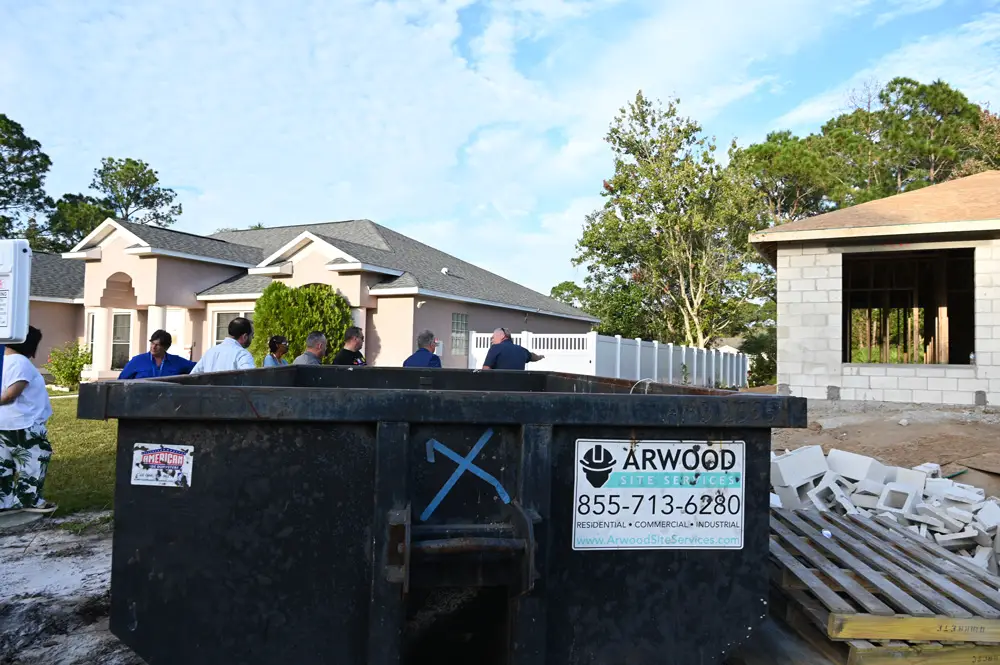
Note: this is one of two articles on this subject today. See the other: “All Those Yards Flooding from New Construction? Blame ITT, Nature or Changing Codes, But Not Builders, City Finds.”
![]()
Should Palm Coast government provide more than advice and technical help to residents who have seen their front yards and back yards flood as new homes have gone up on adjacent lots, at times rising much higher than their own? Should the city offer financial aid or do some of the required repair work itself on yards that need drainage improvements, rather than leave residents to foot the whole bill?
The answer may be in the legality of it, and the legalities currently and rather clearly speak against providing any kind of treatment that could favor private property owners.
“As far as providing some sort of assistance,” City Attorney Neysa Borkert said, “the city council needs to keep in mind that you can only expend public funds to help the general public. Public funds cannot be used for private gain. So that really has to be a threshold question when considering what type of assistance you’re going to provide to property owners that may be experiencing issues.”
Palm Coast City Council member Ed Danko was heartened by the city administration’s briefing on Tuesday about redirecting staffers’ efforts to gather and analyze data from flooding yards. But it’s not enough. He wants to go further. Though he did not specify how much further, he hinted at increasing the city’s role and commitments.
While he did not mention financial commitments, his proposal quickly drew in cautions and more direct references to such commitments, and how the city should be careful about setting a precedent involving only a relatively restrained segment of its property owners.
Danko was not dogmatically wedded to the idea of specific aid. He wants options or ideas. “That’s why I brought this up,” he said, “to give some direction to staff to begin moving forward and thinking down the road on what we can do for those folks, you know, that have been affected.”
The proposal is opening a new front in the debate over the flooding issue that, one way or another–and legal or not–the council may have to face, especially if it picks up momentum among residents and in Danko’s messaging: he’s running for a County Commission seat, and in the flooding matter has found a strong issue as attention-grabbing as it is of genuine concern for many.
Danko wants a “process” that would alleviate the residents’ issues beyond the ongoing efforts, possibly including a citizens’ committee, possibly including means to help residents shoulder the costs they’ve incurred to deal with the problems. “My thoughts are that we will probably have to set aside money. And I don’t know how much at this point yet. But we need to set aside some money to begin assisting these people.”
Read Related Also: Rottnest Island: Girl, 15, is allegedly sexually assaulted in a toilet block at tourism hotspot
None of the council members dispute the fact that the flooding issue is now a top priority. But the first priority among priorities, Mayor David Alfin and Council member Theresa Pontieri said, is to continue the current focus on data gathering so as to have a factually stronger handle on the issue. He made it explicit: “I don’t want to go down a path that’s going to lead us to something that would expose the city to a liability,” specifying that as “a fiduciary responsibility to make sure we maintain that at all times.”
Pontieri is especially cautious about going in the direction of a special program for a limited number of residents. “I want to tread very lightly as to what we open ourselves up to as a city, because we have 102,000 residents in the city of Palm Coast and they all pay taxes,” Pontieri said. “So we are stewards of every single one of those tax dollars.”
Pontieri no less than Danko has been pushing the administration to address residents’ issues in tangible ways, beyond words and promises. But she, too, puts a premium on process–just a different kind of process than the one Danko is proposing, at least for now: “So we have to be very careful how we look at each one of these properties. I’m a very big proponent right now–I know it’s taking time–of being very diligent about this fact gathering process. I think that’s got to be priority number one.”
For instance, she would have no issue having the flooding matters displace some of the city’s routine inspections, if workforce priorities are an issue.
Council member Nick Klufas fell on Pontieri’s and Alfin’s side as well–ensuring that existing residents with flooding problems are incorporated in the city’s response, and getting the city’s technical manual updated to prevent future problems of the sort.
But it was Neysa Borkert, the city attorney, who applied the strongest brakes on city priorities and commitments. For example, redirecting personnel to focus on flooding issues instead of on permits could cause legal liabilities for the city, because there is a “shot clock” on issuing and following through on building permits and the numerous inspections those require. She would not want to have city staffers placed in a position where they could violate that shot clock.
More pointedly, Borkert very clearly shot down the sort of direct benefit to private property owners that Danko was hinting at. “One person is experiencing issues and setting up some type of program to only fund fixing that lot would not rise the level of being a public benefit for the rest of the public,” Borkert said.
Beyond that, when the city reviews plans and building permits, it would not expose itself to any sort of liability if this or that property ends up flooding, because the city has sovereign immunity: it may not be sued over that sort of responsibilities.
Danko still wants a “two-front attack on this problem,” both to address the future–the technical manual, for example–and the present: the residents who have been harmed by flooding. Council members did not disagree, with an eye to grants that could possibly pick up costs that city funds could not assume directly.
“This is not a problem that goes away,” Alfin said. “I mean, quite frankly, this is a problem that probably only gets worse as we go forward in years. We have a lot of catch up to do with planning that may have seemed ideal at the time, but now, 50 years later, it’s not 30 or 50 years later, we’re finding holes that that we certainly need to plug or shore up at this time.”










